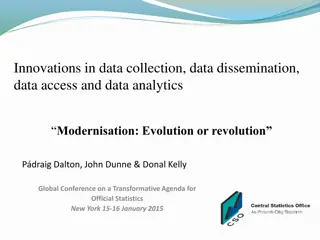Airspace Modernisation at Glasgow Airport: A Strategic Overview
Glasgow Airport Limited is undertaking a major airspace modernisation project to upgrade arrival and departure routes, supported by a long-term development strategy. The initiative aims to meet safety standards, accommodate increased demand, mitigate noise impact, address congestion, enhance airspace access, and promote technological advancements for a sustainable aviation future. The UK's overall objectives for airspace modernisation align with global best practices, emphasizing efficiency and capacity improvements while considering environmental and community impacts.
Download Presentation

Please find below an Image/Link to download the presentation.
The content on the website is provided AS IS for your information and personal use only. It may not be sold, licensed, or shared on other websites without obtaining consent from the author.If you encounter any issues during the download, it is possible that the publisher has removed the file from their server.
You are allowed to download the files provided on this website for personal or commercial use, subject to the condition that they are used lawfully. All files are the property of their respective owners.
The content on the website is provided AS IS for your information and personal use only. It may not be sold, licensed, or shared on other websites without obtaining consent from the author.
E N D
Presentation Transcript
Development of Airspace Design Principles for the Glasgow Airport FASI-North Airspace Change Proposal Version 1.0, 05/09/2019
GLA OVERVIEW Glasgow Airport Limited (GAL) are sponsoring an ACP to upgrade the airport s arrival and departure routes from the ground to 7000ft. and the associated controlled airspace. GAL handled 9.7m passengers in 2018, travelling with 30 airlines to 120 destinations, including major hubs like London Heathrow, Amsterdam, Dubai, Frankfurt, Munich and Dublin. Overview Current situation The airport also handles 16,000 tons of freight per year (a 4-fold increase in the past decade), supported by 57 logistics carriers. The activities and connectivity provided by GAL is estimated to support 30,000 jobs and contribute 1.4bn to the Scottish GDP. The airport is one of fastest growing in Europe. Forecasts indicate the GLA will grow to serve 17m passengers by 2040. A 1bn long-term development strategy has recently been prepared to enable the forecast growth at the airport.
GLA ACP 2016 - 2018 Glasgow undertook an airspace change programme between 2016 and 2018 The key drivers were: Removal of ground-based navigation beacon DVOR. Part of wider industry initiative the CAA s Airspace Modernisation Strategy. Unlock capacity. Consultation ran from 15 January to 13 April 2018 with the required approval and endorsement from the CAA. During week 12 of the 13-week consultation the DfT requested we restart the process under new legislation CAP 1616. The CAA stated the decision did not reflect any judgement about the quality of the airport's consultation to date.
UK STRATEGY FOR AIRSPACE MODERNISATION Airspace modernisation is a UK Government policy objective Glasgow Airport is required to meet EASA legislation on Performance Based Navigation by 2024 (EU 2018/1048). The Aviation Strategy sets out UK s overall objectives for airspace modernisation to deliver: quicker, quieter and cleaner journeys and more capacity for the benefit of those who use and are affected by UK airspace. Main aim of the Airspace Modernisation Strategy (AMS) is to modernise the airspace structure and route network to add the capacity to accommodate forecast growth in demand for aviation in a sustainable way. In Scotland this is coordinated via the FASI North group.
BACKGROUND: OBJECTIVES OF AIRSPACE MODERNISATION The UK Government and its independent aviation regulator (the Civil Aviation Authority) require the UK s airspace to be modernised (redesigned and upgraded) to achieve the following objectives set out in the Airspace Modernisation Strategy. 1. Enable continuous improvements in safety standards. 2. Accommodate growing demand from airspace user groups, including commercial air transport that is key to the UK s transport infrastructure and economy and the Military to meet defense and security requirements. 3. Enable government policies to reduce and mitigate of the impact of aircraft noise on local communities. 4. Deal with hotspots of congestion within the current system. 5. Further enable greater access to airspace for non-commercial users. 6. Improve the resilience of the airspace bad weather or other forms of disruption 7. Encourage the adoption of new technologies that can improve the safety and efficiency of air transport, including advancements in communications, navigation and surveillance and the integration of space flights and drones.
BACKGROUND: REQUIREMENTS ON THE INDUSTRY To deliver these objectives the Government and CAA are co-sponsoring the implementation of the Airspace Modernisation Strategy (known as the AMS or CAP1711), which requires the aviation industry to make a series of investments and deliver a wide-reaching programme of airspace changes. Most of the AMS requirements fall to: Airports: to make airspace changes at lower altitudes (below 7000ft) that upgrade their arrival and departure routes. The UK s Enroute Air Navigation Service Provider (NATS): to make airspace changes to the airways network (above 7000ft) and invest in new systems and tools for air traffic control. Airspace users: to invest in new avionics and improve their approach to flight planning.
FAS IMPLEMENTATION NORTH Many of the airspace changes that the airports and NATS are required to deliver overlap. In the busiest areas of Southern England, Northern England and Scotland the airspace changes have been grouped into two major programmes: Future Airspace Implementation (FASI) North The fundamental redesign of the terminal airspace in northern England and Scotland that is based on the widespread adoption of satellite navigation procedures. Future Airspace Implementation (FASI) South The fundamental redesign of the terminal airspace in Southern England. The FASI North and South airports are responsible for upgrading their individual arrival and departure routes from the ground to 7000ft. NATS are responsible for redesigning the route network above 7000ft. that guides traffic to and from the boundaries of the UK s airspace. The airports and NATS are working closely to ensure that their individual ACPs are aligned and the final set of changes can be combined seamlessly.
GLASGOW AIRPORTS AIRSPACE CHANGE PROPOSAL An airspace change proposal (ACP) is needed at Glasgow Airport to upgrade the airport s arrival and departure routes in line with the requirements of the AMS (and specifically the FASI North initiative). The ACP offers the oppourtunity to: Enhance safety: By reducing/removing safety risk factors from the current operation. Better manage the impact of aircraft noise: By deploying more precise and flexible routes that optimise aircraft performance, avoid noise sensitive areas and offer predictable relief. Increase flight efficiency: By tackling the inefficiencies in the current route structure that lead to aircraft flying longer tracks and sub-optimal climb and descent profiles. Improve network performance: By integrating GLA s routes with those of adjacent airports and the wider terminal airspace network in Scotland and Northern England. Further enable greater access to airspace for non-commercial users: By introducing means to encourage airspace integration (rather than segregation). Strengthen resilience: By introducing additional airspace capacity for redundancy in the event of disruption. Optimise the performance of existing infrastructure by configuring the airspace to deliver the most efficient use of existing runway capacity.
THE REGULATORY AIRSPACE CHANGE PROCESS Every ACP sponsor must follow the regulatory process for changing the airspace design, including community engagement requirements - known as CAP1616 (Civil Aviation Publication no. 1616). CAP1616 sets out the process for developing airspace change options. This entails engaging with affected stakeholders, evaluating the impacts of options, consulting with the public, regulatory assessment and implementation. The outputs of each stage are reviewed by the CAA to ensure the engagement and analysis is robust prior to moving to the next stage.
CAP1616 STAGE 1: DEFINE Our ACP is currently in Stage 1 of the CAP1616 process known as the Define Stage. As a first step (1a), we have prepared a Statement of Need that sets out the issues that our ACP is seeking to address and we have met with the CAA to discuss how we will progress through the process. The design principles aim to capture all important considerations that should be factored in when developing airspace design options. Some principles will be based on fundamentals like safety, operational and environmental performance; others may be specific to local circumstances. The second step of Stage 1 (1b) is to draw up design principles that we will use later in the process, to guide how airspace change options are developed and evaluated. Our design principles will be drawn up through discussions with a mix of stakeholders that are potentially affected by the airspace change.
OUR APPROACH TO DEVELOPING AIRSPACE DESIGN PRINCIPLES For the Stage 1 gateway meeting we are required to submit a set of proposed design principles to the CAA with an explanation of how these were developed and influenced through our engagement with stakeholders. We are following a four-step approach: 1. Gather inputs from stakeholders about the potential impacts of our airspace change, through targeted two-way conversations around six themes. 3. Refine the design principles through a second round of targeted engagement, consider the prioritisation of the principles and any stakeholder objections. 4. Submit our proposed set of design principles to the CAA, along with an explanation of how they were created and influenced through the engagement with stakeholders. 2. Develop an initial set of design principles based on the feedback gathered during step 1 and share them with stakeholders for their consideration.
THEMES TO GATHER STAKEHOLDER INPUTS There are several themes associated with the drivers for, and impacts of, an airspace change that may be considered when developing design principles. These include: 1. Safety (overriding priority) 2. Capacity 3. Noise 4. Airspace access and integration 5. Flight efficiency 6. Use of advanced navigation technology
1. SAFETY Aviation safety is considered the first and overriding priority for a framework intended to guide the development of airspace design options. Airspace change is an opportunity to enhance safety performance by reducing, and even removing, risk factors from the operation. As traffic levels grow and the airspace accommodates a larger number of flights, continuous enhancements in safety are considered necessary to maintain the established level of safety performance per flight. Airspace modernisation often involves the deployment of new concepts and technologies that could introduce new safety risks. These must each be assured independently and collectively as part of an overall system approach to aviation safety. Discuss: The principle(s) related to aviation safety that are particularly important when developing airspace design options.
2. CAPACITY A main driver for most ACPs progressed by the commercial air transport sector is the introduction of additional airspace capacity to support existing flights without generating delays and accommodate the forecast increase in traffic levels over time. The capacity of our airspace depends on the ability of air traffic controllers to secure the expeditious flow of traffic through designated sectors. Capacity is restricted when the volume of traffic through a given sector is predicted to exceed a level that controllers can manage safely. For additional airspace capacity in the vicinity of the airport to accommodate flights without delays it must be integrated effectively with the wider terminal airspace network, the capacity of the runway and the capacity used by neighboring airports. The potential capacity of the airspace to accommodate a given number of flights can only be achieved if the key capabilities required to support the operation (e.g. resources, procedures and technology) are in place. Discuss: The principle(s) related to airspace capacity that are particularly important when developing airspace design options.
3. NOISE Airspace design options should seek to minimise the total adverse effects of aircraft noise at lower altitudes. Airspace design options should conform as far as possible to the existing arrival and departure swathes to limit the number of new flights over people that were previously unaffected by aircraft noise. The airspace design options should consider multiple routes that can be switched on and off to reduce the impact of noise. The use of multiple routes may increase the total number of people affected by noise, including people that were previously unaffected. Other methods to manage the impact of noise, like alternating the way that inbound and outbound traffic is sequenced, could also be included in the airspace design options where operationally feasible. Discuss: The principle(s) related to noise that are particularly important when developing airspace design options.
4. AIRSPACE ACCESS AND INTEGRATION The AMS promotes the concept of airspace integration, rather than segregation, to meet the demands of all airspace users in a safe and efficient way. The airport s airspace design will be developed and deployed in the same timeframe as the other FASI North airports upgrade their own arrival and departure routes. NATS are developing plans to upgrade the terminal airspace in northern England and Scotland to accommodate the forecast traffic growth (as part of FASI North). The airport s airspace design should integrate seamlessly with the wider network and not constrain the other airport's plans. In addition, the airspace structures deployed to support air transport operations at GAL should not place disproportionate limitations on other airspace users access to the airspace. Discuss: The principle(s) related to airspace access and integration that are particularly important when developing airspace design options.
5. FLIGHT EFFICIENCY Where introducing the capacity to enable growth is often a main driver of an airspace change. Ensuring any growth is sustainable is an essential requirement as set out in government policy. Flight efficiency improvements could be enabled by the airspace change through more continuous climb and descent profiles and shorter track miles. Steeper climbs and approaches and shorter routes are usually more fuel efficient for aircraft to fly and generate fewer emissions. Airspace design options should also consider the impact of routes on local air quality. Discuss: The principle(s) related to flight efficiency that are particularly important when developing airspace design options.
6. USE OF ADVANCED NAVIGATION TECHNOLOGY The ground-based NAVAIDs that the airport's existing routes rely on are being removed because they are old and outdated. All new routes should be designed to an advanced satellite navigation standard that aircraft can fly to high levels of track keeping accuracy and with minimal intervention from air traffic controllers. With new navigation technology there should be less need for air traffic controllers to regularly vector aircraft away from their designated route (generating greater predictability that underpins better noise management). The use of advanced navigation standards enable routes to be designed with the precision and flexibility to avoid more noise sensitive areas and buildings. But advanced navigation also creates the potential to concentrate traffic swathes. For some departure routes, there may be a trade-off between climbing quickly and making early turns to avoid noise sensitive areas and buildings. Discuss: The principle(s) related to advanced navigation technology that are particularly important when developing airspace design options.
NEXT STEPS All stakeholders will receive a copy of today s presentation and the list of potential design principles based on the feedback received from all three workshops. There are two scheduled follow-up workshops on Thursday 3rd and Friday 4th of October. Stakeholders may attend either one for a second round of engagementg. These will again be at The Corinthian Club. Please direct all feedback, comments and enquiries to: airspace@glasgowairport.com or call 0800 298 7040.























